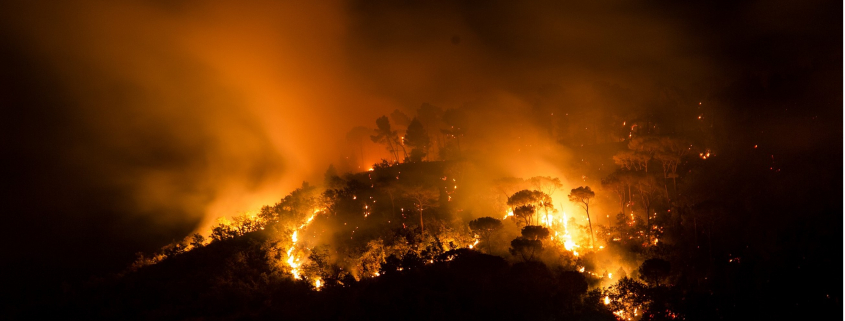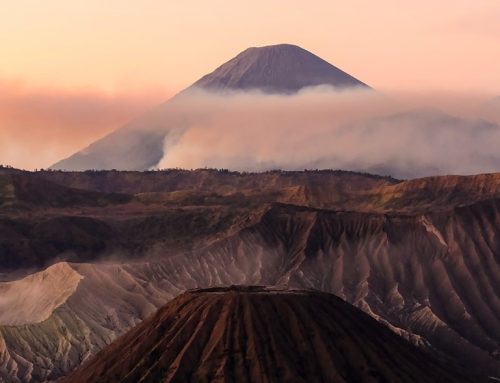By Craig Duncan | ACICIS Intern at The Environment Institut
Data from Global Forest Watch shows the growing impact of forest fires. Showing almost twice as much tree cover today is destroyed in wildfires, compared to 20 years ago. [1]

The gradual increase globally of tree loss from fire
Source: Global Forest Watch
With the growing rate of fires, it seems unsurprising that the past few years have seen some of the most devastating wildfires in human history.
Global Forest Watch’s data shows, that in 2021 the tropics lost 11.1 million hectares of tree cover from wildfires. [3]
3.75 million hectares of primary rainforests were lost in these fires. Areas that are crucial for carbon storage and biodiversity.
The boreal forests of Russia have seen some of the most devastation. Losing over 18.16 million hectares of forest to fire in 2021; the worst fire season in the country’s modern history. [2]
Russia, Canada, The U.S., Brazil and Australia have had the highest rate of forest loss due to wildfires in the past 20 years. [4]
Excluding Brazil, the forests of the remaining countries have all adapted to yearly fires. The boreal forests of Russia, Canada and the U.S., all rely on fire to clear old growth and release nutrients for new plants into the soil.
Certain pine trees develop pinecones known as ‘serotinous cones’ which store seeds for years and only release them after being exposed to extreme heat. This allows these seeds to germinate on the newly burnt forest floor, and new growth to occur. [5]
Australia too has forests that have adapted for fire. The eucalypt forests of Australia contain countless trees thriving, despite tremendous burn marks decorating their bark.

Australia is a land of fire; a charred forest is a common sight.
Photo from Pixabay – By Terri Anne Allen
Fire is such an abundant part of Australian culture, that the Nyoongar people local to southwest Australia speak of ‘Birak’ the first of their six seasons. It runs from December to January, known as the season of the young or ‘burning time’. [6]
In spite of this, Australia saw its largest most devastating bushfire in the summer of 2019-2020; known as the ‘Black Summer Bushfires’. [8]
Over 24 million hectares were lost in these bushfires. An estimated 1.8 million hectares were burnt so thoroughly they might never recover. [7]
Along with this, rainforests and wet forests were set alight. Which, unlike the eucalypt forests, are not adapted to fire, and also may never recover.
A Drying Climate
The driving cause of the increasing intensity of wildfires is climate change.
As temperatures rise globally, summers become longer and hotter, winters become shorter and drier. Our forests and grasslands become more susceptible to ignition from lightning strikes.
Lightning is responsible for the majority of fire ignitions. It must be recognised; however, a small percentage are started accidentally, or even intentionally. [10]
In 2021, wildfires were responsible for 1.76 billion tonnes of carbon emissions globally. [9]
The burning of forests releases carbon stored within, increasing our greenhouse effect, leading to hotter and dryer periods which then lead to more intense fires. [figure 2]
We have become trapped within a fire-climate feedback loop. [4]
The boreal forests of America and Russia are being burned at an astonishing rate. These forests can hold nearly twice as much carbon as tropical rainforests, which is released into the atmosphere when these forests burn.
Climate change and deforestation have also degraded tropical forests significantly. Drying them out and making them more prone to burning. Tree cover loss from fire in the tropics has increased by around 5% over the past 20 years. [4]

Forest fires contribute significantly to emissions which leads to more intense fires.
Source: Global Forest Watch
Fighting Fire With Fire
One way countries like Australia and the U.S. try to reduce wildfires’ impact is to start smaller fires.
Prescribed burning, or fuel reduction burning is a common practice within Australia and is rising in use globally.
Firefighters create smaller fires at cooler times in the year that they can manage and control. These fires remove the leaf litter and undergrowth of forests. This reduces the risk of fires starting in these areas. It also slows the spread and helps reduce the intensity of wildfires if they do ignite, as the fire has less fuel to burn. [10]
For the boreal forests of America, and the eucalypt forests of Australia, this form of fire suppression is key. As both ecosystems have adapted to operate with fire, the total suppression of all fire has a high impact on biodiversity. [10]

Fuel reduction burns are effective in reducing the intensity of unplanned fires. Photo from Pixabay – By Terski
Australia – Burning Biodiversity

Over 60,000 Koalas were killed in the 2019-2020 bushfires. Koalas have been declared endangered as of 2022.
Photo – By Craig Duncan
The ‘Black Summer Bushfires’ of 2019-2020 are known to have claimed the lives of over one billion native animals in Australia. Though, some estimates suggest up to three billion animals perished or were displaced during the fires. [11]
In a low-intensity fire such as a fuel reduction burn, many animals can hide underground in burrows, or travel to the higher branches of trees to avoid the fire.
However, intense fires like The Black Summer Bushfires decimate animal populations.
Larger mammals are greatly impacted by severe fires as they have fewer places they are able to shelter. Severe fire spreads significantly faster than low-intensity fires. Therefore, severe bushfires are inescapable for larger animals on the ground.
As our fire seasons intensify, so too will the rate of animal death in these fires.
Indonesia – The Heat Of Peat
According to data from The Global Forest Watch, 2015 to 2016 were the most devastating years for tropical forest loss due to forest fires. [4]
Indonesia was impacted by major fires from 2015 to 2016. However, the Head of The Centre for Disaster Studies, from the University of Riau, Dr Sigit Sutikno said 80% of these fires occur within the peatlands of Indonesia.

Indonesia lost a significant amount of forest cover in 2015 & 2016, though since then, Indonesia’s deforestation rates have been dropping.
Source: Global Forest Watch
He detailed these peatlands, saying they are over 6000 years old. The peatlands of Indonesia range over 20 million hectares, making them some of the largest in the world.
Mr Sutikno went on to say, the peatlands of Indonesia are also excellent carbon sinks. Unfortunately, as they burn they release a significant amount of that carbon stored.
Due to climate change, these peatlands have begun drying out significantly over the years, making them more susceptible to fire. Mr Sutikno notes, that when these peatlands burn, an area as large as 90 hectares can be burned in a single day.
To tackle this, significant effort has been implemented to maintain these peatland environments. Keeping them moist is the main priority, which is achieved by using ‘artificial rain’. The landscape of Indonesia is drastically different from the boreal forests or the eucalypt forests, and Mr Sutikno assures, that the rainforests of Indonesia are currently too humid to be at major risk to fire.
However, if our dry seasons continue to elongate, and fires in peatlands become more intense. Much like the rainforests of Australia in 2019 and 2020, or the Amazon of Brazil, Indonesia’s rainforests could soon be at risk.
A Need For Change
The past few years have been relentless with global record highs for temperature. This year alone the United Kingdom experienced its hottest day – ever.
There is no better indicator of the dangers of run-away climate change than the devastation caused by these wildfires.
With our current climate emergency, it has never been more apparent that decisive action is required immediately.
Not only to reduce our current impact but to protect our environment for the future.
References
[1] Global Forest Watch Content. (2022). Two Decades of Fire-Driven Loss in Unprecedented Detail | GFW.[online] Available at: https://www.globalforestwatch.org/blog/data-and-research/trends-tree-loss-from-fires-unprecedented-detail/ [Accessed 5 Sep. 2022]. [2] Roth, A. (2021). Russia forest fire damage worst since records began, says Greenpeace. [online] theGuardian. Available at: https://www.theguardian.com/world/2021/sep/22/russia-forest-fire-damage-worst-since-records-began-says-greenpeace. [3] Global Forest Watch Content. (2022). What Happened to Forests in 2021? | Global Forest Watch Blog.[online] Available at: https://www.globalforestwatch.org/blog/data-and-research/global-tree-cover-loss-data-2021/. [4] Mongabay Environmental News. (2022). Forest fires are getting worse, 20 years of data confirm. [online] Available at: https://news.mongabay.com/2022/08/forest-fires-are-getting-worse-according-to-new-20-year-analysis/ [Accessed 5 Sep. 2022]. [5] Georgia, U. of (n.d.). Serotiny and the Serotinous Cone. [online] Treehugger. Available at:
https://www.treehugger.com/serotiny-and-the-serotinous-cone-1342894. [6] Bom.gov.au. (2016). Nyoongar calendar – Indigenous Weather Knowledge – Bureau of Meteorology.[online] Available at: http://www.bom.gov.au/iwk/calendars/nyoongar.shtml. [7] Clarke, H., Collins, L., Clarke, M., Nolan, R.H., Bradstock, R. and Penman, T. (2021). A staggering 1.8
a million hectares burned in ‘high-severity’ fires during Australia’s Black Summer. [online] The
Conversation. Available at: https://theconversation.com/a-staggering-1-8-million-hectares-burned-in-high-severity-fires-during-australias-black-summer-157883. [8] Commonwealth Parliament; Parliament House, C. (n.d.). 2019–20 Australian bushfires—frequently asked
questions (updates). [online] www.aph.gov.au. Available at:
https://www.aph.gov.au/About_Parliament/Parliamentary_Departments/Parliamentary_Library/pubs/rp/rp2122/201920AustralianBushfiresFAQupdate. [9] World Economic Forum. (n.d.). This is how much carbon wildfires have emitted this year. [online] Available at: https://www.weforum.org/agenda/2021/12/siberia-america-wildfires-emissions-records-2021/#:~:text=said%20on%20Monday. [10] Commonwealth Parliament; Parliament House, C. (n.d.). 2019–20 Australian bushfires—frequently asked
questions (updates). [online] www.aph.gov.au. Available at:
https://www.aph.gov.au/About_Parliament/Parliamentary_Departments/Parliamentary_Library/pubs/rp/rp2122/201920AustralianBushfiresFAQupdate. [11] Parliament of Australia (2020). 2019–20 Australian bushfires—frequently asked questions: A quick guide.[online] Parliament of Australia. Available at:
https://www.aph.gov.au/About_Parliament/Parliamentary_Departments/Parliamentary_Library/pubs/rp/rp1920/Quick_Guides/AustralianBushfires. [12] Commonwealth Parliament; Parliament House, C. (n.d.). Bushfires and fuel reduction burning. [online] www.aph.gov.au. Available at:
https://www.aph.gov.au/About_Parliament/Parliamentary_Departments/Parliamentary_Library/pubs/rp/rp2122/FuelReductionBurning.





